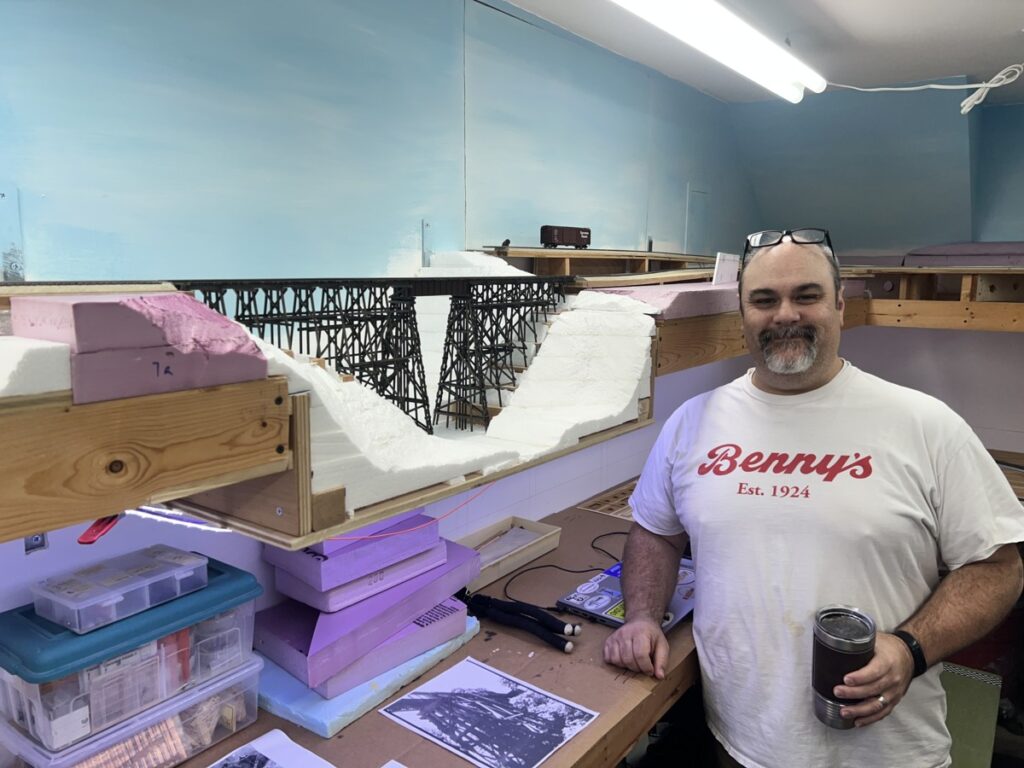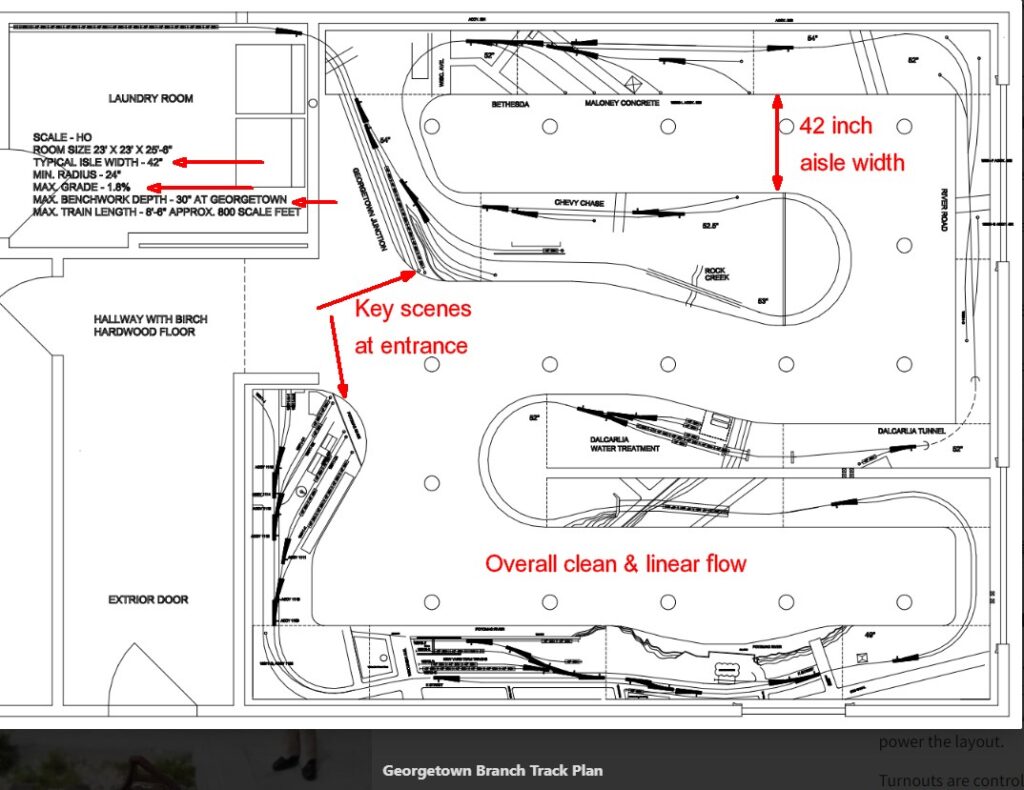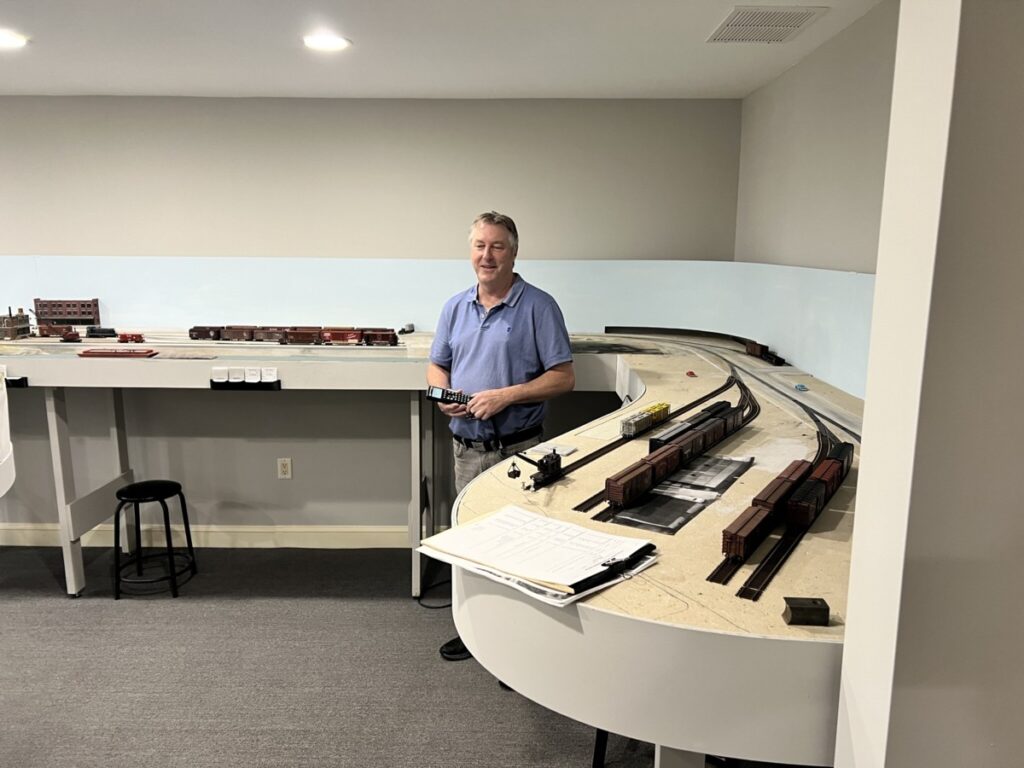
Ben Sullivan stands in front of his masterful rendition of the Georgetown Branch’s Rock Creek Viaduct. Results like this come from being in the game long term, making mistakes, learning from them, and moving forward. Attitude and approach to the hobby goes a long way.
The last two weekends were particularly enjoyable for me, both being spent visiting with hobby veterans Ben Sullivan and Kelly Regan. Each is modeling one of my favorite prototypes, B&O’s Georgetown Branch. Although they are excellent builders, what I’ve enjoyed most about my visits is seeing their overall approach and attitude as well as how they collaborate on philosophy, photo sharing, and helping one another out.
It’s worth checking our attitudes and approach to the hobby from time to time. Doing so insures we continue to find it satisfying and also results in better models over the long term. I’ve seen the full spectrum over the decades. For some, none of their efforts are ever good enough (to them at least) which leads to constantly starting over and never getting anything done. On the other end of the spectrum you have those that crank stuff out like an assembly line but never take stock of what they’re doing. When this happens the quality of the work doesn’t improve over time. Finally, you have the chest-pounding braggarts, which thankfully are in the minority.
What is a healthy approach? First, it’s being in the game as I wrote in my December 11th blog. Build stuff consistently. In terms of attitude, for me, I’ve come to this:
“I recognize each modeling effort as representing the best I could do given my skill level at the time and give myself a pat on the back for being in the game. I don’t get too high or too low. Finally, I dispassionately examine my work and make mental notes for subtle improvements to try on the next go around.”
When I complete a project, I put it on the layout and live with it for a few years. I have had three or four cases where I made a second pass at a model and replaced the original effort. Doing so was fun but it’s rare and I only do it after a few years have passed.
Getting back to Kelly and Ben the one thing we talked about a lot was our past layout building snafu’s and how, without them and the lessons they taught us, it would be impossible to improve. You simply can’t get a sense of spatial relationships, the time involved in completing various construction tasks, the mechanics of construction, and hidden landmines from parking on social media and forums all day. While both Ben and Kelly start their track planning in CAD, they only use that as a starting point and then quickly move on to a heavy reliance on full size mock-ups of track and structures to test the final composition.
A few lessons from these “battle-scarred veterans” I noticed were:
Ben had just finished an exquisite scratch-built model of the Rock Creek viaduct (see lead photo). It was rivet-by-rivet perfect. However, with experience, you learn there are times you need to split from the prototype. He’d put meticulous effort into modeling the nut-bolt-washer castings. On the prototype, they’re the same color as the surrounding wood, rendering them all but invisible. Ben subtly highlighted the NBW parts, painting them a slightly lighter color to create contrast. The hue was just different enough to get the job done without being in your face. The end result was impressive. It really made the model snap.

Shown above is Kelly’s track plan, a design I’d consider excellent for reasons that go beyond what you see on paper. This design didn’t come from endless philosophical debates on the forums but rather from having built several previous layouts and learning some hard lessons. A few points to take note of:
-The two signature scenes are located on each side of the door, not hidden in the back.
-Aisles are generous.
-The room is CLEAN!
-The backdrop was kept deliberately low.
-You can easily and comfortably follow a train down the branch.
-Sight lines are controlled.
-Grades are modest.

Kelly stands in front of his Georgetown scene. Note the open look, the low backdrop, the impact of the overall cleanliness of the room.
The only way to truly improve over the decades is to be in the game and get the battle scars that go along with doing so. If you don’t occasionally examine your work and look for areas of improvement you won’t get better. On the flip side, constantly beating yourself up is unfair and self-defeating.
What was that old commercial, “Be Like Mike”? I’ll revise that and say be like Ben and Kelly.
You can see more of their work here:
Kelly’s 3D Store (note the excellent wheel stops)